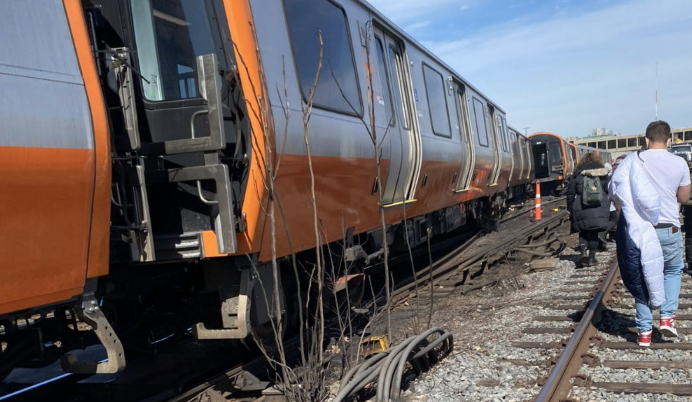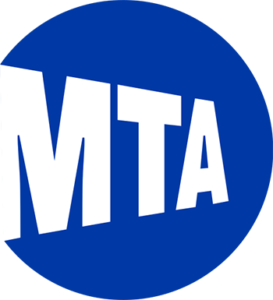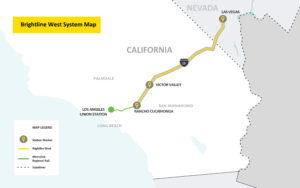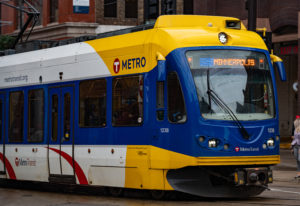MBTA investigating several possible causes of March derailment, exacerbating tensions with CRRC
Written by David C. Lester, Editor-in-Chief
As RT&S reported in a story by Editor-in-Chief Bill Wilson on March 17, MBTA experienced a derailment of a new six-car train on the Orange Line in a work zone at Wellington Station on March 16. No one was hurt, but officials have been trying to determine what went wrong.
Debate on cause of derailment
Yesterday (June 7), MBTA reported that a probable contributor to the derailment was a problem with a track switch at the point of derailment.
Readers may recall that the new cars for the Orange Line were constructed in Springfield, Mass. by CRRC, a Chinese state-owned and publicly traded rolliing stock manufacturer.
Another contributing factor, according to Jeff Gonneville, deputy general manager of MBTA, is that as the cars collect more mileage, it becomes increasingly difficult for the wheel sets to turn, because the truck, or “bogie” itself has greater difficulty turning. Trying to figure out why this is occurring has kept the cars sidelined for three months. Drilling deeper into the inspection of the trucks, it appears that the side bearer pads have deteriorated. These pads regulate the amount of force required to turn the wheels.
Gonneville reported that CRRC, on the other hand, says the switch was a greater factor in the derailment because it lacked a guard rail, and because the pitch of the track and coefficient of force required to roll the wheels across the track were problematic.
MBTA has reiterated that the bearer pads issues and no guardrail on the switch both contributed to the derailment, and MBTA and CRRC agree that the force required to turn the wheels does not meet design specifications.
While Gonneville said the tracks and swtich at Wellington Station will be rebuilt, a CRRC spokeswoman said their company disagrees with MBTA’s assertion that the side bearer pads played a significant part in the derailment. Moreover, while both companies are working to get the cars back on the tracks, no date has been set for this.
CRRC also said that “Based on third party analysis, CRRC has determined the root cause of the derailment was lack of guardrail at the point of derailment and excessive wheel friction. Simulation results under hypothetical scenarios including with or without the guard rails and by accounting for the worst track conditions further demonstrates infrastructure issues.
“Although we understand that MBTA must take every step to exhause any and all scenarios that led to the derailment, we will not, as a reputable railcar builder, accept fault for an incident of such sensitivity when reports are identifiying other contributing factors. We pledge to work with the MBTA to ensure further analysis and more creative simulations are conducted to confirm our understanding of the root cause of the derailment.”
CRRC celebrating other U.S. contract wins
Today (June 8), CRRC plans a media event to celebrate work on subway cars for Los Angeles. Officials in southern California voted to by 64 new subway cars for the Los Angeles Metro Red Line and Purple Line from CRRC at a cost of $178.4 million.
MBTA, on the other hand, placed a $566 million 152 Orange Line cars and 252 Red Line cars, then ordered an additional 120 Red Line cars, with a total production cost of for all orders of nearly $900 million. The Orange Line and the Red Line projects are to be finished in 2023 and 2024, respectively
This deal was a segue to CRRC building a car-building factor in Springfield, with shells built in China, and 60% of the parts made in the U.S. As the MBTA deal was concluded, other transit agencies made deals with CRRC. In addition to the Los Angeles project, the Southeastern Pennsylvania Transportation Authority (SEPTA) ordered 45 double-decker cars from CRRC, carrying a price tag of $137.5 million.
Choppy air for CRRC
The MBTA project has run into several problems. Supply chain issues, worker training issues, all exacerbated by the pandemic. Also, the MBTA cars built by CRRC have demonstrated several mechanical problems, including door problems and excessive noise from the car undercarriage.
U.S. government officials and transit industry officials have pursued efforts to keep the Chinese firm out of the U.S. transit industry. In addition, challenges with overall Chinese trade relations with the U.S. have created more kinks in the process.
CRRC U.S. market entry opposed from the start by many
The entry of CRRC into the U.S. market has created controversy and opposition for several years. A key argument is that CRRC is able to underbid competitors for lucrative rail car contracts because the company is owned by the Chinese government and, therefore, receives significant subsidies to keep it’s contract bids low.
In addition, there have been concerns in some quarters around national security issues, suggesting that CRRC could build various monitoring devices in the rail cars that would compromise U.S. national security.
This story will continue to evolve in the coming months and years.





